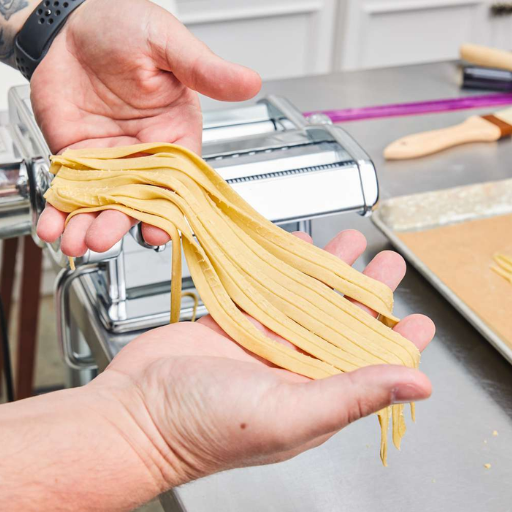If you have ever appreciated the taste and feel of genuine homemade pasta, making pasta from scratch must appeal to you. I have a guide that should help you choose a pasta machine that suits your needs best so that you can make fresh, delicious pasta in the comfort of your kitchen. This complete guide has everything for everyone, whether it is a beginner who wants to venture into the world of making pasta or a professional cook who intends to upgrade his/her equipment. We shall discuss different types of machines used for making pasta, their characteristics, and their advantages; we will also look at various factors that one should consider before purchasing such devices. Prepare yourself for some profound culinary transformation. Once you find this ideal appliance, all your cooking dreams will come true while bringing Italy’s flavors into every meal at home.
What is a pasta maker and How Does it Work?
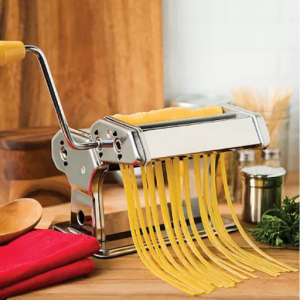
Image source: https://www.kohls.com/
A pasta maker is a kitchen appliance that makes you make fresh pasta at home more efficiently. There are two main types of these machines: manual and automatic. Usually, when having a hand crank, the first ones require you to flatten the dough through the rollers and then shape it into different forms with cutters. Conversely, the second type mixes and kneads dough for you before pushing it out through perforated disks, creating various noodle shapes in this way. Both variants serve one purpose, which is simplifying pasta production to get even thickness, texture, and size – difficult things when done manually.
Understanding the pasta maker
To understand a pasta maker, you must know its significant parts and what they do. Rollers, cutters, and sometimes extruders are the most common components of both manual and automatic pasta-making machines. In the case of a manual machine, first of all, prepare a dough; then, using adjustable rollers fed through by hand-crank, achieve the necessary thickness. Once the dough has been flattened, it is time to change it onto the cutter attachment to create preferred pasta shapes like spaghetti or fettuccine.
Automatic machines make this process even simpler by having built-in mixers and kneaders that allow adding ingredients directly into them. The dough is mixed automatically and then kneaded before being extruded through various interchangeable discs that make different types of pasta, ranging from penne to lasagna sheets.
The type of pasta maker that should be chosen depends on individual needs and personal preferences. A good machine should be strong enough and easy to clean with several settings for different thicknesses. Additional features, such as automatic shut-off or speed settings, can be added for more convenient use. Regardless of whether it is manual or automatic, one thing remains true – quality pasta makers ensure uniformity in texture and thickness, thus making it possible even for beginners to make homemade pasta at ease while having fun at the same time.
Advantages of Using a pasta machine
A pasta device has numerous benefits that can improve the procedure and the finished product. To begin with, it guarantees uniformity in thickness so that every noodle is cooked equally throughout and absorbs sauces better than when done manually, which may be inconsistent at times, especially for those looking forward to professional outcomes while still at home. Secondly, they take less time rolling or cutting dough, whereby one can spend hours doing this job by hand. Still, machines do it within minutes, making them indispensable tools, especially during bulk preparations. Thirdly, different shapes are complex to make without using any machine other than pasta machines; therefore, many of these devices could allow for various types of pasta, which adds to your culinary diversity. Lastly, healthier eating habits go hand in hand with using such equipment since you have more control over what goes into it, thus eliminating preservatives and other additives commonly found in bought ones from stores. In general terms, not only does a pasta maker increase the standards of homemade pasta, but it also makes this process efficient and fun.
Key Components: roller and cutter
When discussing the key components of a pasta machine, the roller and cutter are pivotal. The roller is essential for flattening the dough to the desired thickness, which can usually be adjusted to accommodate different pasta types, from lasagna sheets to spaghetti strands. A high-quality roller ensures smooth and even dough consistency, which is crucial for achieving professional results. Conversely, the cutter is responsible for slicing the flattened dough into various pasta shapes. Different types of cutters can produce a range of pasta styles, such as fettuccine, tagliolini, and pappardelle. Together, these components streamline the pasta-making process, making it more efficient to produce uniform and aesthetically pleasing pasta at home.
How to Make Fresh Pasta with a Pasta Machine?
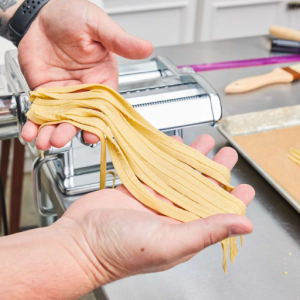
In order to make fresh pasta using a pasta machine, do the following:
- Prepare the Dough: Mix three large eggs and a pinch of salt into 2 cups flour. Stir until you get dough. Knead dough on a floured surface for around 10 minutes or until smooth elastic; wrap in plastic wrap and let rest for 30 minutes.
- Set Up the Machine: Securely attach your pasta machine to a table or countertop, and set the rollers at their widest setting.
- Roll the Dough: Break the dough into smaller pieces. Take one piece and flatten it out into a rectangular shape, then feed it through the roller. Fold this sheet in half and run it back through the rollers a few more times, each time making the setting narrower than before until the desired thickness is achieved.
- Cut Pasta Shapes: Attach a cutter to the end of the machine; pass flattened sheets through to create desired shapes, such as fettuccine or spaghetti.
- Cooking The Pasta: Boil pot of salted water; cook fresh pasta for 2-3 minutes till ‘al dente’ [tender but still firm when bitten]. Drain well, then serve with your favorite sauce.
Enjoy your homemade pasta!
Preparing Your Pasta Dough
To begin making pasta dough, create a hill of flour on a clean surface and make a hole in the center. Into that hollow, break the eggs and add a little salt. Whisk the eggs gradually with the surrounding flour using a fork until a lumpy dough is formed. For 10 minutes, knead it vigorously until it turns soft and stretchy. Cover it with plastic wrap and let it sit at room temperature for half an hour before rolling out or shaping it as desired; this will enable its gluten to rest, making it more pliable.
Setting the thickness setting on Your pasta roller
When ready to roll out your pasta dough, Set your roller to its most comprehensive, which is usually number one on most machines. Pass it through these rollers, then fold it in half before passing again at the same point without altering anything; repeat thrice so that you can give some structure to this mixture. However, having done all these initial rolls, progressively reduce thickness one step each time while feeding through after every change without folding until required thinness is attained, usually around five or six for different types of pasta, but not limited there since various machines may have their settings altered accordingly depending to the kind being prepared.
Using the roller and cutter for Perfect Pasta
When the dough is rolled to the correct thickness, you should cut it into your desired shape. Fix the cutting part in a pasta-making machine. Dust flour onto the dough gently to prevent sticking, and then feed the rolled dough sheet into the cutter. Different cutting parts can achieve various shapes, such as fettuccine or spaghetti. To keep all strands apart while finishing the remaining dough, sprinkle the cut pasta with more flour and mix lightly. If you prefer a dry texture, let it dry slightly after cutting; if not, cook immediately. Ensure that follow a few minutes of boiling time instruction in boiling water given for fresh pasta, which usually requires only a few minutes in boiled water. Have fun with your best homemade pasta!
What are the Best Pasta Makers of 2024?
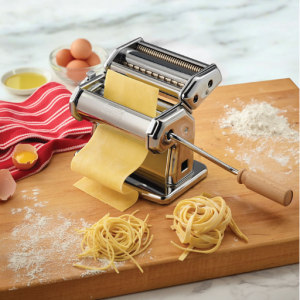
Regarding the most excellent pasta manufacturing devices in 2024, several models are resilient, effective, and easy to use. At the very top of the list is the Marcato Atlas 150, which is known for being strongly built and flexible; this machine has many thickness settings and cutting attachments that can be replaced easily. Another favorite is Philips Pasta Noodle Maker, especially among people who find convenience important; they love it because everything is done automatically – mixing, kneading, and extruding, thus making preparation time shorter than ever before. If you are looking for an electric option, Imperia Electric Pasta Maker should be your choice since, apart from having a powerful motor, it’s also straightforward to operate. Last but not least, the KitchenAid Pasta Roller Cutter Set designed as an attachment for the KitchenAid stand mixer would suit those individuals who already own the device but want more functions. All these machines consistently make good quality homemade pasta.
Top Picks for Best Pasta Maker
Here are the current top three pasta-making machines based on reviews from websites:
- Marcato Atlas 150
- Website 1: The Marcato Atlas 150 is known for its traditional Italian craftsmanship and excellent durability and efficiency ratings. It’s built solidly, has many thickness settings, and can handle various types of pasta.
- Website 2: This machine is praised for its simplicity and reliability. Users love how smoothly it operates and that they can add multiple attachments to it.
- Website 3: Almost all reviewers agree that this product performs fantastically at a professional level. They also like how easily it cleans up after use and that it is built strong enough for long-term use.
- Philips Pasta and Noodle Maker
- Website 1: What sets the Philips Pasta Maker apart is that it’s automatic! Reviewers love this feature because they believe with automation comes simplicity. Essentially, all you have to do is load ingredients into the machine, which then takes care of mixing dough, kneading dough, extruding dough, etc., until delicious noodles appear.
- Website 2: People adore that fresh pasta can be ready in minutes thanks to this model by Philips – perfect when you’re short on time but still want homemade meals!
- Website 3: A versatile appliance such as the Philips Pasta Maker deserves applause; however, some users say having different discs only adds convenience rather than being necessary, which creates more variety among styles according to certain comments left behind by visitors who tried them out before me testing any units myself ;-).
- Imperia Electric Pasta Maker
- Website 1: Individuals seeking electrical alternatives without sacrificing quality should consider Imperia Electric Pasta Makers. Their powerful motors combined with user-friendly designs make them easy even for beginners!
- Website 2: Those who frequently work large amounts of dough will appreciate how well made these models are plus critics weren’t lying about being able to handle batches effortlessly either way depending on what works best in your kitchen.
-
Website 3: Many reviewers are happy with this product because it consistently produces good results while not requiring much effort to make different pasta shapes like those mentioned above.
All these top-ranked pasta machines have something special about them that caters to everyone’s needs so that everyone can have an ideal experience cooking homemade spaghetti.
Features to Look for in the Best Pasta Machine
When you hunt for the best pasta maker, some important features should be taken into account so that the machine can perform at its best and satisfy your needs.
- User-friendliness: This can be manual or electric, but its simplicity matters most. Machines with features such as mixing, kneading, and extruding automatically save time and energy.
- Variety: The machine should have different attachments or discs that can make various pasta shapes, which makes it more versatile and, thus, increases its appeal.
- Durability/Quality: Quality is determined by the type of material used in making it since those constructed using solid and long-lasting materials will work consistently without breaking down quickly over some time. Most people prefer stainless steel machines due to the reliability and robustness they come with during the construction process.
- Ease of cleaning: It is important to go for models that can be cleaned easily because this helps maintain hygiene levels high at all times, thus extending the life span of these appliances. Some parts should also be dishwasher-friendly, while others may require one’s hands only, making cleaning much easier than expected.
- Speed and Performance: Such machines must have powerful motors coupled with efficient designs. Otherwise, they will not handle large batches of dough within a short period and, hence, fail to produce smooth professional-grade pasta consistently as expected.
These points will enable one to choose a pasta maker that satisfies all requirements and makes making homemade pasta more enjoyable.
Comparison of Leading Brands: Marcato Atlas 150 vs Imperia
According to the most frequently recommended pasta machines, top review sites highly rank the Marcato Atlas 150 and the Imperia models. Here is a brief comparison based on some essential features:
Marcato Atlas 150:
- Ease of Use: The Marcato Atlas 150 is known for being easy to use. It has a knob that can be adjusted to ten different thicknesses for precise control over how thick or thin you want your noodles.
- Versatility: This machine comes with attachments that allow it to make various styles of pasta and can be fitted with motors to do everything automatically if desired.
- Durability and Build Quality: Made of nickel-plated and chrome-plated steel, this model’s construction is both solidly built and attractive, ensuring many years of use without showing any signs of wear or tear.
- Ease of Cleaning: Although the machine is not dishwasher safe, all detachable parts make it quite simple to clean by hand.
- Performance and Speed: The smoothness with which dough passes through this machine during operation allows batches containing large amounts or small quantities thereof to produce uniformly high-quality spaghetti strands without fail.
Imperia:
- Ease of Use: For a beginner who wants something less complicated than other models may have to offer, then they should go for an Imperia pasta maker because it’s very easy to use. It just requires one to turn the handle as they push their dough through six interchangeable thickness settings until satisfied with the desired thickness level.
- Versatility: Notwithstanding its limited versatility compared against Marcato Atlas 150 – though still coming complete with additional shapes such as lasagna attachment options, etc. also there exists an optional motor unit which can be purchased separately if need be
- Durability and Build Quality: The imperial frame is made from chrome-plated steel, while rollers have been crafted using high-quality chromium plating material; this ensures a long-term usage period without getting worn out easily due to rusting or other forms of damage caused by prolonged exposure to moist conditions
- Ease of Cleaning: The same way like cleaning process for Marcatos Atlas 150 can be done here as it is not safe to wash any of these machines using dishwasher detergents since they tend to corrode their metallic components over time, leading to weakened structural integrity; thus, dismantling them apart then washing with soapy water followed by rinsing off under running tap regular clean
-
Performance and Speed: The Imperial has been designed to roll out very smooth, even pasta dough, but this may take longer compared to similar types because it only comes fitted with three-thickness settings, which allow users to produce thinner sheets while still obtaining excellent results.
To sum up, if you love making pasta at home, then either a Marcato Atlas 150 or Imperia will work just fine. The former offers more versatility because of additional features, while the latter shines through simplicity, which is so much loved by newbies.
Why Choose a Manual Pasta Maker Over an Electric Pasta Machine?
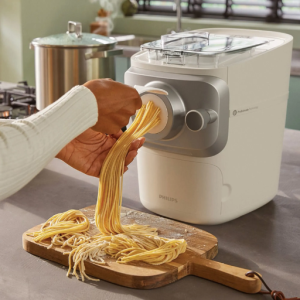
People usually base their decisions on control, price, and tradition when choosing between an electric and a manual pasta maker. The thickness and texture of the pasta can be regulated well with the help of manual pasta makers, thus allowing more involvement in cooking on a personal level. Additionally, they are cheaper and more robust because they lack many parts that may wear out over time. Besides being fulfilling and enjoyable, making pasta by hand links individuals with centuries-old pasta production culture. Furthermore, these machines take up less counter space than their counterparts and are easier to put away. In general terms, accuracy is essential; also, if one wants cheapness and authenticity during pasta preparation, then he or she should buy this type of machine for making noodles at home.
Benefits of manual pasta machines
Hand-operated pasta machines are good because they are:
- Better Dough Control: The main feature is the flexibility to adjust dough thickness manually. This enables one to make precise and different types of pasta that always come out with an ideal texture and consistency.
- Cheapness: Manual pasta makers are generally less expensive than their electric counterparts. Their use of basic materials reduces their cost, making them within reach for many home cooks.
- Durability: These devices last long because they have fewer moving or electrical parts. They wear out slowly, prolonging their useful life while decreasing maintenance demands.
- Compactness/Portability: Such equipment occupies smaller counter spaces and can also be stored conveniently. It does not require much room, which makes it perfect for kitchens with limited space availability.
- Traditionalism/Authenticity: Using a hand-operated machine during pasta preparation brings one closer to traditional cooking methods. This step may be therapeutic and rewarding, enhancing the overall process of making meals.
- Ease of Use: Even though manual effort is necessary in this case, it does not complicate matters because machines of this kind are easy to handle. Neither power sockets nor complex adjustments are needed, thus making them suitable for both beginners and experienced chefs.
In summary, hand-operated pasta machines provide affordability, durability, control over thickness levels, and originality in cooking, which is loved by many spaghetti lovers.
Drawbacks of Using Electric Pasta Makers
- Greater Price: Electric pasta makers are usually more costly than manual ones. The additional convenience and advanced features are only available if you pay for them; therefore, these devices become a bigger investment for most families.
- Dependence on Power Source: Such machines cannot work without being plugged into an electrical outlet. This may pose a problem in kitchens with few outlets or during blackouts with no power. Furthermore, this reliance on electricity can be seen as a disadvantage by people who prefer doing things manually using their hands.
- Difficult to Clean: Electric pasta makers tend to have more parts that need careful cleaning because of their complex design and construction. Unlike them, manual ones can be quickly taken apart for thorough cleaning, which makes maintaining electric models time-consuming and labor-intensive.
- Large Size and Storage Space: Larger than manual models, they take up more counter space, and their bulkiness makes storage difficult. Consequently, individuals with small kitchens or limited storage options might not find these devices suitable for their needs.
-
Breakdowns: Since there are moving parts involved besides just motor failure, many other things can go wrong with such machines, leading to high repair costs over time due to frequent breakdowns associated with electric pasta makers.
Which is Easier to Maintain?
About maintenance, electric pasta-making machines are often more complicated to keep than manual pasta-making machines. Manual pasta-making machines have fewer parts and are less difficult, so taking them apart and cleaning them is easy. Moreover, unlike the electric ones, these do not rely on electrical connections, which may get spoilt or need fixing, reducing their failure rates and repair requirements. Conversely, on the other hand, in contrast, etcetera – means that sometimes it does not apply to all situations or conditions but only one part of an observation or statement – but still can be used for giving more information about something mentioned before (like “but” in this case). Electric pasta makers usually contain complex systems that demand carefulness during cleaning and maintenance procedures. They require more attention than any other type of mechanical device used in households, such as vacuums, cleaners, or dishwashers, because there are many moving parts involved here which, if not cleaned properly, could lead to breakdowns, thus making it necessary for them to be serviced by professionals who charge hefty fees for their services.
How to Choose the Right Pasta Maker Attachment for Your Needs?
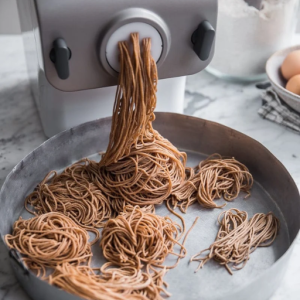
When selecting a pasta maker attachment, keep these points in mind:
- Kind of Pasta: Identify the type of pasta you want to make. Some attachments are created for spaghetti, while others are made for fettuccine or ravioli, among other varieties. Choose an attachment that can create your desired pasta type.
- Compatibility: Ensure the attachment is compatible with your pasta maker or stand mixer. Check the manufacturer’s specifications to avoid buying an incompatible product.
- User-Friendliness: Go for easy-to-install-use-clean attachments. Those with few parts will generally be simpler to handle and maintain.
- Quality of Material: Look for stainless steel attachments that are durable and long-lasting. They also give better results over time.
-
Price and Brand: Think about how much money you’re willing to spend, then select from reputable brands that manufacture reliable kitchen appliances; sometimes, it’s worth investing more at first so as to save on repairs or replacements later on.
Different Types of pasta maker attachments
Pasta maker attachments are designed in different forms, each with the goal of helping you make various pasta shapes and styles. Below are some examples:
- Spaghetti Attachment: Designed to produce perfectly even strands of spaghetti, this attachment is best suited for lovers of traditional Italian cuisine.
- Fettuccine Attachment: This one is wider than spaghetti so it helps in making fettuccine which is a very versatile type of pasta that can be matched with many different sauces.
- Ravioli Attachment: If you love stuffed pastas then the ravioli attachment will be your best friend; it creates little pockets or squares of dough which can be filled with anything from cheese to meat.
- Lasagne or Lasagnette Attachment: This should do just fine for those who want their noodles wide and flat like they do when making lasagna at home without using any no-boil sheets!
- Capellini or Angel Hair Attachment: Produces thin delicate strings known as angel hair or capellini; perfect for light sauces.
All these attachments will greatly enhance your cooking skills by enabling you to produce a variety of homemade pasta, thereby allowing for easy and accurate preparation of different meals.
Compatibility with Kitchenaid Stand Mixer and Other Brands
The majority of pasta makers can be attached to many different machines, but some are only designed to fit into popular mixers such as those made by KitchenAid. These attachments are recommended because they are easy to use and seamlessly integrate into the company’s line of stand mixers. They should work with any model if it has a power hub where they can be fastened.
The same cannot be said for all other brands, however; certain models require specific adapters in order for universal pasta maker attachments or those created by different manufacturers like Cuisinart and Bosch (which have their own optimized versions) to fit properly while still functioning at full capacity. Nonetheless, third-party companies also produce these types of devices that claim compatibility with multiple mixer brands, extending options even further.
It is important not to forget to check what each maker states about its product’s limitations before buying anything lest one ends up disappointed due to lack-of-fit or poor performance caused by an incompatible match between two different products which were never meant to go together according to instructions from neither side involved in their making process – this mistake could easily have been avoided had anyone bothered reading through manufacturer specifications along with relevant guides regarding compatibility issues related specifically towards ones own personal machine type.
How to Use pasta cutter attachments to Create Various pasta shapes
After you have learned how to use various pasta shapes with pasta cutter attachments, it is easy. Start by mixing flour, eggs, and a pinch of salt together until it has a smooth consistency to make your pasta dough. Let the dough rest, then divide it into manageable portions and roll each one through the pasta roller attachment on your stand mixer, gradually decreasing the thickness setting until the desired thinness is achieved.
Next, swap out this attachment for an appropriate shape, like spaghetti, fettuccine, linguine, etc., and feed a guide between your hands gently. While rolling out these sheets, it will slice them into even strands or shapes—don’t forget to dust some flour over them to prevent sticking.
In addition, there are other cutters available that can produce different shapes; for example, use a ravioli maker attachment that fills pasta, or a lasagna cutter that makes wide noodles. Read what manufacturers say about usage instructions; always get good results. Finally, boil homemade fresh pasta for a few minutes and eat with sauce.
What is the Marcato Atlas 150 Pasta Machine and Why is it Popular?
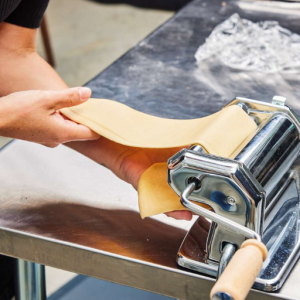
The Marcato Atlas 150 Pasta Machine is a much-praised manual pasta maker that is famous for its long life, accuracy, and flexibility. It is made in Italy from robust materials that include a stainless steel body and nickel-plated rollers for durability and consistent results. Its popularity comes from the fact that it can create many different shapes and thicknesses of pasta easily due to an adjustable dial with interchangeable cutting attachments. Furthermore, this machine is easy to use and clean; therefore, many amateur cooks, as well as professional chefs who want genuine homemade pasta, prefer it.
Overview of the Marcato Atlas 150
A highly flexible pasta machine recognized widely for being constructed solidly and easy to use is the Marcato Atlas 150. Made out of steel coated in chrome or nickel, this device ensures longevity with a sleek finish. The adjustment knob has ten positions so that users can make sheets ranging from very thin (0.6mm) up to quite thick ones (4.8mm). Also included are double cutter attachment sets, which enable one to produce fettuccine among other shapes such as tagliolini, etcetera. Additionally, maintenance and cleaning are simple tasks for anyone who uses this product since it can be fitted with more accessories, expanding its capability of making different types of pasta, hence becoming a must-have item among those keen on preparing their own meals at home.
Key Features of the Marcato Atlas 150 Pasta Machine
- Sturdy Build: The Marcato Atlas 150 is made from strong materials like steel coated with chrome for its body and rollers that are anodized aluminum which guarantees strength and durability over a long period of time.
- Thickness Settings That Can Be Adjusted: This pasta maker has a knob for adjusting thickness with ten different positions, thus allowing one to choose how thick they want their pasta sheets to be, ranging between 0.6mm up to 4.8mm hence giving wide varieties in terms of types and texture of pasta.
- Many Kinds Of Pasta Can Be Made With One Machine: This device can create fettuccine and tagliolini, among other shapes, using its double cutter. It also supports various attachments, such as those used in making spaghetti, ravioli, or lasagna, thereby enabling users to create different styles of pasta.
- Simplicity when it comes to usage coupled with low maintenance requirements: Being designed for ease of use, the Marcato Atlas 150 does not require sophisticated skills or knowledge on the part of the operator; besides, it is easy to clean due to simplicity in design, meaning that even people without much experience can comfortably use it without any difficulties as well as clean it effortlessly after every use, therefore, being an ideal choice for starters and experienced cooks too.
-
Authentic Italian Product: Manufactured in Italy, where craftsmanship is highly valued, this brand represents true Italian artisanship at its best, ensuring unmatched pasta-making moments compared to other machines within a similar category.
User Reviews and Ratings
Users on diverse platforms highly regard the Marcato Atlas 150 Pasta Machine. Here’s a compilation of user feedback and ratings:
- Amazon:
- Rating: 4.7 out of 5 stars
- Key Points: Many users have praised the machine’s sturdy construction. Several reviewers have also highlighted its easy operation. Most people agree that adjustable thickness settings and versatility in terms of different pasta shapes are great features. In short, it makes consistent, good-quality pasta that can be easily cleaned up afterward.
- Williams Sonoma:
- Rating: 4.8 out of 5 stars
- Key Points: This appliance has received applause for its strength and how smoothly the rollers work together during operation. It allows for making varieties such as fettuccine or lasagna using extra accessories that come separately but fit perfectly into this product. Also, people said they love the look of this thing because Italian design brings elegance to any kitchen.
- Sur La Table:
- Rating: 4.6 out of 5 stars
- Key Points: Many reviewers have praised durability, saying that once you buy one – never again will there be a need to purchase another pasta maker thanks to strong construction materials used here combined with traditional craftsmanship from Italy; those who enjoy trying out new types of noodles find adjustable settings very helpful indeed while the cleaning process remains simple throughout all these years still maintaining highest hygiene standards required by law.
Overall the Marcato Atlas 150 Pasta Machine has received acclaim for its quality, flexibility and ease-of-use – making it a firm favourite among home cooks who like to make their own fresh pasta from scratch.
Frequently Asked Questions (FAQs)
Q: What is the best type of pasta maker machine to buy for beginners?
A: For beginners, a hand crank pasta maker machine is a great option because it is easy to use and allows you to control the rolling and cutting process manually. The Oxgord Pasta Maker and the Imperia Pasta Maker, made in Italy, are excellent manual machines suited for those new to pasta making.
Q: How do I make pasta at home using a noodle maker?
A: To make pasta at home using a noodle maker, start by preparing your dough using a basic pasta recipe. Once your dough is ready, use the machine to roll it into sheets of pasta. You can then use the noodle maker’s cutter to slice the pasta sheet into noodles of your desired thickness and shape.
Q: Are there pasta makers that can attach to kitchen appliances?
A: Yes, there are pasta maker attachments for KitchenAid stand mixers, such as the KitchenAid Pasta Roller and Cutter Set. These attachments make it easy to roll and cut pasta by leveraging the power of your stand mixer.
Q: What are the benefits of using a pasta drying rack?
A: A pasta drying rack is beneficial because it helps to air-dry your fresh pasta evenly, preventing it from sticking together. This can be particularly useful when making large batches of pasta, allowing the pasta to dry in individual strands or shapes.
Q: What features should I look for in a pasta maker machine?
A: Key features to look for include adjustable thickness settings (such as seven adjustable thickness settings), build quality, ease of cleaning, and whether the machine includes multiple attachments for different pasta types. Machines like the CucinaPro Pasta Maker Deluxe Set offer a range of useful features.
Q: How does the KitchenAid Pasta Press differ from the KitchenAid Pasta Roller?
A: The KitchenAid Pasta Press is designed to extrude pasta into different shapes, such as macaroni or fusilli, whereas the KitchenAid Pasta Roller flattens the dough into sheets of pasta, which can then be cut into noodles using other attachments. Both are pasta maker attachments for KitchenAid stand mixers but serve different purposes.
Q: Are there electric pasta makers available to make pasta more easily?
A: Yes, there are electric pasta and noodle makers that automate the process of mixing, kneading, and extruding pasta. These machines are typically easy to use and can save time and effort compared to manual pasta makers.
Q: What makes a pasta machine “deluxe”?
A: A “deluxe” pasta machine often comes with additional features and attachments, such as multiple cutters for different types of pasta, a sturdy build quality, and sometimes additional accessories like a pasta drying rack or a detailed pasta recipe book. These extras enhance the overall pasta-making experience and convenience.
Q: Are all pasta makers made in Italy of high quality?
A: Many pasta makers made in Italy are renowned for their quality and craftsmanship, such as the Imperia Pasta Maker. Italian pasta makers often focus on durability, functionality, and producing authentic pasta textures, making them a popular choice among pasta enthusiasts.












